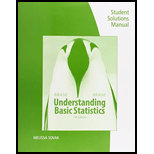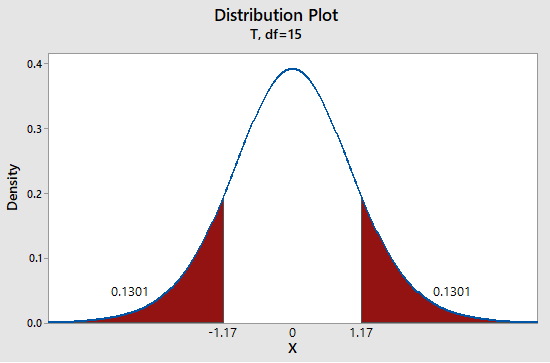
Concept explainers
(a)
The level of significance, null and alternative hypothesis & determine whether we should use a left-tailed, right-tailed, or two-tailed test.
(a)
Answer to Problem 14P
Solution: The level of significance is
Explanation of Solution
The level of significance is defined as the probability of rejecting the null hypothesis when it is true, it is denoted by
Null hypothesis
Alternative hypothesis
Since
(b)
To find: The sampling distribution that should be used along with assumptions and compute the value of the sample test statistic.
(b)
Answer to Problem 14P
Solution: The sampling distribution of
Explanation of Solution
Calculation:
| A | B | d = A - B | ||
| 12.7 | 9.8 | 2.9 | 3.24 | |
| 13.4 | 14.5 | -1.1 | 4.84 | |
| 12.8 | 10.7 | 2.1 | 1 | |
| 12.1 | 14.2 | -2.1 | 10.24 | |
| 11.6 | 13 | -1.4 | 6.25 | |
| 11.1 | 12.9 | -1.8 | 8.41 | |
| 14.2 | 10.9 | 3.3 | 4.84 | |
| 15.1 | 10 | 5.1 | 16 | |
| 12.5 | 14.1 | -1.6 | 7.29 | |
| 12.3 | 13.6 | -1.3 | 5.76 | |
| 13.1 | 9.1 | 4 | 8.41 | |
| 15.8 | 10.2 | 5.6 | 20.25 | |
| 10.3 | 17.9 | -7.6 | 75.69 | |
| 12.7 | 11.8 | 0.9 | 0.04 | |
| 11.1 | 7 | 4.1 | 9 | |
| 15.7 | 9.2 | 6.5 | 29.16 | |
| Sum | 206.5 | 188.9 | 17.6 | 210.42 |
| Average | 12.90625 | 11.80625 | 1.1 | 13.15125 |
The d distribution is mound shaped and symmetrical and we have a random sample of
Using
(c)
To find: The P-value of the test statistic and sketch the sampling distribution showing the area corresponding to the P-value.
(c)
Answer to Problem 14P
Solution: The P-value of the test statistic is 0.2602.
Explanation of Solution
Calculation:
We have t = 1.17
Using Table 4 from the Appendix to find the specified area:
Graph:
To draw the required graphs using the Minitab, follow the below instructions:
Step 1: Go to the Minitab software.
Step 2: Go to Graph > Probability distribution plot > View probability.
Step 3: Select ‘t’ and enter d.f = 15.
Step 4: Click on the Shaded area >X value.
Step 5: Enter X-value as 1.17 and select ‘Both Tail’.
Step 6: Click on OK.
The obtained distribution graph is:

(d)
Whether we reject or fail to reject the null hypothesis and whether the data is statistically significant for a level of significance of 0.01.
(d)
Answer to Problem 14P
Solution: The P-value
Explanation of Solution
The P-value of 0.2602 is greater than the level of significance (
) of 0.01. Therefore we don’t have enough evidence to reject the null hypothesis
(e)
The interpretation for the conclusion.
(e)
Answer to Problem 14P
Solution: There is not enough evidence to conclude that there is difference in the population average birthrate and death rate in this region.
Explanation of Solution
The P-value of 0.2602 is greater than the level of significance (
) of 0.01. Therefore we don’t have enough evidence to reject the null hypothesis
Want to see more full solutions like this?
Chapter 10 Solutions
Student Solutions Manual for Brase/Brase's Understanding Basic Statistics, 7th
- This is the information about the actors who won the Best Actor Oscar: Best actors 44 41 62 52 41 34 34 52 41 37 38 34 32 40 43 56 41 39 49 57 35 30 39 41 44 41 38 42 52 51 49 35 47 31 47 37 57 42 45 42 44 62 43 42 48 49 56 38 60 30 40 42 36 76 39 53 45 36 62 43 51 32 42 54 52 37 38 32 45 60 46 40 36 47 29 43 a. What is the variable? What type? b. Construct an interval-frequency table, with columns containing: class mark, absolute frequency, relative frequency, cumulative frequency, cumulative relative frequency, and percentage frequency.arrow_forwardans c plsarrow_forwardCritically analyze the following graph and, based on statistical information, indicate the type of error it presents IN NO MORE THAN 3 LINES SCOTCEN POLL OF POLLS SHOULD SCOTLAND BE INDEPENDENT? NO 52% YES 58% LIVE CAW NAS & 28.30 HAS KILLED MORE THAN 2,600 IN WEST AFRICA, WORLD HEALTH ORG. BROOKEBCNNarrow_forward
- Critically analyze the following graph and, based on statistical information, indicate the type of error it presents IN NO MORE THAN 3 LINES PRESIDENTIAL PREFERENCES RODOLFO CARTER 3% (+2pts) EVELYN MATTHEI 22% (+6pts) With the exception of President Boric, could you tell me who you would like to be the next president of Chile? CAMILA VALLEJO 4% (+2pts) JOSÉ ANTONIO KAST 19% (+5pts) MICHELLE BACHELET 6% (+1pts)arrow_forwardCritically analyze the following graph and, based on statistical information, indicate the type of error it presents IN NO MORE THAN 3 LINES 13% APPROVE 4% DOESN'T KNOW DOESN'T RESPOND 5% NEITHER APPROVES NOR DISAPPROVES 78% DISAPPROVES SURVEY PRESIDENTIAL APPROVAL DROPS TO 13%arrow_forwardPlease help with this following question I'm not too sure if question (a) and (b) are correct and not sure how to calculate (c) The csv data is below "","New","Current" "1","67",66 "2","77",73 "3","76",73 "4","76",76 "5","77",79 "6","84",76 "7","71",78 "8","84",72 "9","73",76 "10","71",73 "11","72",77 "12","70",72 "13","75",72 "14","84",71 "15","77",73 "16","65",72 "17","69",73 "18","71",73 "19","79",71 "20","75",78 "21","76",69 "22","73",74 "23","76",71 "24","64",74 "25","81",78 "26","79",76 "27","70",77 "28","79",71 "29","84",73 "30","79",69 "31","69",72 "32","81",76 "33","77",70 "34","77",71 "35","71",69 "36","67",72 "37","70",76 "38","77",73 "39","82",73 "40","72",73arrow_forward
- Please help me answer the following question(c) A previous study found that 15% of nurses reported participating in mental health support programs.From the 96% found in (b) , can you conclude that proportion of nurses reported participating in mental health support programs p(current), has changed from the previous study?(Yes/No) because the confidence interval in (b) (captures/does not capture) 15%.(d) Refer to your answer in (b) : The Alberta Nurses Association expects that not more than 23 % of nurses will participate in the survey on mental health support programs. Given the result in part (b) can we conclude that this expectation is reasonable?(Yes/No) because the (upper bound/lower bound) of the 96% confidence interval is (less than/not less than/greater than) 23%. The Alberta Nursing Association conducts an annual survey to estimate the proportion of nurses who participate in mental health support programs. The most recent application of this survey involved a random sample of…arrow_forwardPlease help me solve this questionThis is what was in the csv file:"","Diabetic","Heart Disease""1",32644,30646"2",789,1670"3",12802,36274"4",2177,5011"5",1910,3300"6",3320,4256"7",61425,39053"8",19768,28635"9",19502,39546"10",5642,12182"11",107864,152098"12",29918,60433"13",2397,3550"14",41559,34705"15",49169,57948"16",72853,83100"17",2155,2873"18",140220,134517"19",28181,26212"20",18850,38637"21",69564,68582"22",13897,12613"23",6868,9138"24",9735,4767"25",12102,13447"26",36571,50010"27",44665,55141"28",26620,33970"29",25525,29766"30",14167,20206Q(b) From this, the relationship between these two variables is (non-existent/positive/negative) . I can categorize this relationship as being (strong/weak/moderate).Q(c) Drop down is (+/-)Q(d) Drop downs in order are __% of the (average/median/variation/standard deviation) in the (the number of people diagnosed with heart disease/the number of people diagnosed with diabetes)−variable can be explained by its (linear relationship/relationship)…arrow_forwardPlease help me answer the following question The drop down for question (e, f, and g) is (YES/NO) Based on the P-value above, the assumption of equal variances among the four machines (Is Met/Is Not Met) Based on the data, the average fill for machine 3 is (statistically lower than/statistically higher than/the same as/not statistically different than/statistically different than/Hard to say then when comparing to/Refuse to say when comparing to) machine 1.arrow_forward
- Business Discussarrow_forward1 for all k, and set o (ii) Let X1, X2, that P(Xkb) = x > 0. Xn be independent random variables with mean 0, suppose = and Var Xk. Then, for 0x) ≤2 exp-tx+121 Στ k=1arrow_forwardLemma 1.1 Suppose that g is a non-negative, non-decreasing function such that E g(X) 0. Then, E g(|X|) P(|X|> x) ≤ g(x)arrow_forward
 College Algebra (MindTap Course List)AlgebraISBN:9781305652231Author:R. David Gustafson, Jeff HughesPublisher:Cengage Learning
College Algebra (MindTap Course List)AlgebraISBN:9781305652231Author:R. David Gustafson, Jeff HughesPublisher:Cengage Learning Glencoe Algebra 1, Student Edition, 9780079039897...AlgebraISBN:9780079039897Author:CarterPublisher:McGraw Hill
Glencoe Algebra 1, Student Edition, 9780079039897...AlgebraISBN:9780079039897Author:CarterPublisher:McGraw Hill

